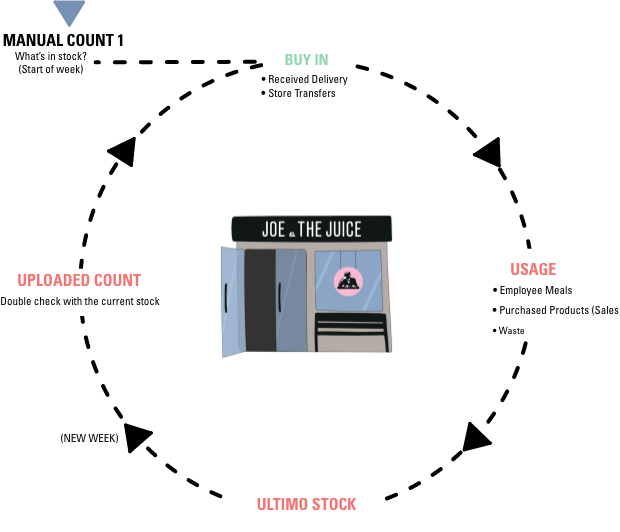How Auto Count Works
Auto count is based on a mathematic formula, where three factors are used. Manual Count (MC), Buy In and Usage (POS Sale, Waste, Employee Meals) are used to calculate an Ultimo Stock (end stock).
MANUAL COUNT
The Manual Count is a regular count done monthly instead of weekly. The Manual Count is the foundation for the auto count formula to work, which is why Manual Count must be thoroughly done.
BUY IN
Buy in is all the goods that are delivered to the store including store transfers. This is determined by the store ideals.
USAGE
The usage is calculated from all the POS Sales, Employee Meals and items wasted on the waste feature. To calculate the usage, it requires the store to have a good type-in culture, where all extra toppings, change of milks and employee meals are typed in on the POS. The stores must waste all items that are not used due to expiration, items lost on the floor, products not sold, etc.
ULTIMO STOCK
The Ultimo Stock is calculated from the Manual Count, Buy In and Usage. This is done by adding the Manual Count and the Buy In together, and then subtract it with the Usage, which results in the Ultimo Stock.

The Ultimo Stock is an almost accurate forecast, which is now used to calculate the needed Buy In for the next weeks. In order to assure a minimum of delivery mistakes, the Manager needs to compare their stock to the weekly report (further explanation later)
Each count follows a one-month cycle:

Friday Procedures
Every Friday morning the Manager will receive an PDF file with expected stock, where 12 KEY and low stock items are highlighted. It’s the Managers responsibility to cross check the PDF stock report with the current stock. If the current stock deviates from the Report, the Manager MUST report the differences to the Purchasing Manager.
It's important to notice that this is a quick checkup that should take no longer than 20 MINUTES.
*THESE 12 KEY ITEMS, WILL ALWAYS BE THE SAME EVERY WEEK, THESE WILL NEVER CHANGE. LOW STOCK ITEMS WILL DIFFERIENTIATE EACH WEEK.
A deviation in the PDF stock report vs. the Actual Stock is when 1 or more boxes of apples are missing, in other words, the deviation should be noticeable right away.
FOLLOW THE 5 STEPS BELOW, TO SECURE A STABLE AND HEALTHY STOCK GOING FORWARD:
- Open the weekly stock PDF on Fridays
- Crosscheck the stock from the night before with the weekly stock PDF - note down larger deviations
- Send an e-mail to the local Purchasing Manager with all the deviations found
- If no deviations are found, send a confirmation e-mail to the Purchasing Manager that everything looks good
- Done!
Key understanding and Actions
Employee Meals
Usage: Every product consumed by the team should be recorded in the POS as an employee meal. If an employee product isn't recorded, it will appear as pure waste.
Actions: Inform all juicers about the "Type In" culture. Ensure they understand the rules for extra toppings—one per product.
IMS (Ingredients, Measurement, Sequence)
Usage: Whenever IMS is not followed, the over usage will appear as waste. Therefore, IMS must be followed at all times.
Actions: Train the team on IMS and explain why it is important to follow these guidelines.
Waste
Usage: Use the Waste feature to help the Purchasing Manager track why a store might have a high waste percentage. Registering waste provides a clear picture of all goods leaving the store, affecting future deliveries for more precision.
Actions: Regularly remind the team to register waste and explain its importance.
Stock
Be observant of stock levels daily. It's important to know which ingredients are missing, low, or overstocked.
Delivery (Buy-In)
Usage: Track the number of goods delivered to your store. Missing goods can appear as waste if not registered. Ensure all incoming goods are accurately recorded using Store Task. If any goods are in bad condition, contact your local Purchasing Manager for a credit note and follow their advice.
Actions: Check all deliveries for low-quality items and any other issues. Always follow up with your local Purchasing Manager.

How can wrong POS Type-in impact the stock
EXAMPLE OF WRONG TYPE IN ON THE POS:
One guest orders 3 Yellow Latte (corresponds to 1 litre/0.25 gallon of milk), the guest would like the three Yellows to be with Semi Skimmed Milk. When three Yellows are typed in, the POS will choose whole milk as the default milk, if this is not corrected the following scenario will happen.
Because the three Yellows are based on Semi Skimmed Milk there will be missing 1 litre/0.25 gallon of Semi Skimmed Milk in the Ultimo Stock whereas there will be an over stock of 1 litre/0.25 gallon of whole milk. If this is an ongoing issue, it will ultimately result in an overstock of Whole Milk and the store running Out of Stock on Semi Skimmed Milk. This is because the deliveries are based on the Ultimo Stock.
How to videos
Cleaning Tasks





























































































